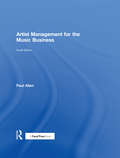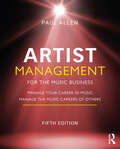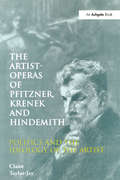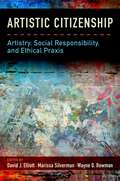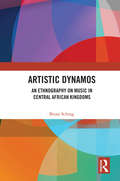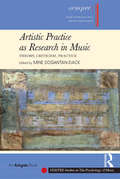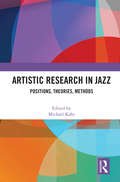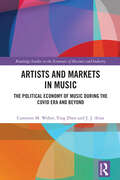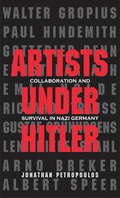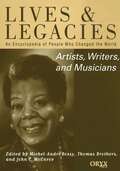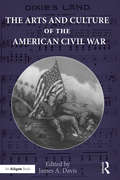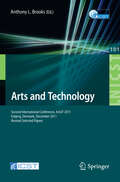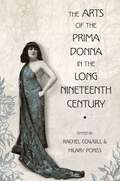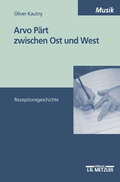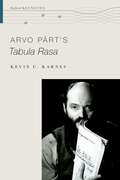- Table View
- List View
Artist Management for the Music Business
by Paul AllenAnyone managing an artist’s career needs to be well versed and have a savvy understanding of the moving parts of the music business. You’ll learn how and why those moving parts "move," as well as how to manage and navigate a music-based career. Artist Management for the Music Business gives you a comprehensive view of how to generate income through music and how to strategically plan for future growth. The book is full of valuable practical insights. It includes interviews and case studies with examples of real-world management issues and outcomes. Updates to this new edition include the importance of online streaming to music careers, how anyone can effectively network, tools for successful negotiation, ways to identify and manage income sources, and guidance on the ever-changing social media landscape of the music business. This book gives you access to resources about artist management and the music business at its companion website, http://www.artistmanagementonline.com. There is no login, and the resources are updated regularly.
Artist Management for the Music Business
by Paul AllenAnyone managing an artist’s career needs to be well versed and have a savvy understanding of the moving parts of the music business. You’ll learn how and why those moving parts "move," as well as how to manage and navigate a music-based career. Artist Management for the Music Business gives you a comprehensive view of how to generate income through music and how to strategically plan for future growth. The book is full of valuable practical insights. It includes interviews and case studies with examples of real-world management issues and outcomes. Updates to this new edition include the importance of online streaming to music careers, how anyone can effectively network, tools for successful negotiation, ways to identify and manage income sources, and guidance on the ever-changing social media landscape of the music business. This book gives you access to resources about artist management and the music business at its companion website, http://www.artistmanagementonline.com. There is no login, and the resources are updated regularly.
Artist Management for the Music Business: Manage Your Career in Music: Manage the Music Careers of Others
by Paul AllenAnyone managing an artist’s career needs to be well versed and have a savvy understanding of the moving parts of the music business. Learn how and why those moving parts "move," as well as how to manage and navigate a music-based career. Artist Management for the Music Business gives a comprehensive view of how to generate income through music and how to strategically plan for future growth. The book is full of valuable practical insights. It includes interviews and case studies with examples of real-world management issues and outcomes. Updates to this new edition include a new chapter for independent, self-managing artists, expanded and updated sections on networking, social media, and streaming, and a basic introduction to data analytics for the music business. This book gives access to resources about artist management and the music business at its companion website, www.artistmanagementonline.com.
Artist Management for the Music Business: Manage Your Career in Music: Manage the Music Careers of Others
by Paul AllenAnyone managing an artist’s career needs to be well versed and have a savvy understanding of the moving parts of the music business. Learn how and why those moving parts "move," as well as how to manage and navigate a music-based career. Artist Management for the Music Business gives a comprehensive view of how to generate income through music and how to strategically plan for future growth. The book is full of valuable practical insights. It includes interviews and case studies with examples of real-world management issues and outcomes. Updates to this new edition include a new chapter for independent, self-managing artists, expanded and updated sections on networking, social media, and streaming, and a basic introduction to data analytics for the music business. This book gives access to resources about artist management and the music business at its companion website, www.artistmanagementonline.com.
The Artist-Operas of Pfitzner, Krenek and Hindemith: Politics and the Ideology of the Artist
by Claire Taylor-JayThis is the first book-length study of the genre of 'artist-opera', in which the work's central character is an artist who is uncomfortable with his place in the world. It investigates how three such operas (Pfitzner's Palestrina (1915), Krenek's Jonny spielt auf (1926) and Hindemith's Mathis der Maler (1935)) contributed to the debate in early twentieth-century Germany about the place of art and the artist in modern society, and examines how far the artist-character may be taken as functioning as a persona for the real composer of the work. Because of their concern with the place of art within society, the works are also engaged with inherently political questions, and each opera is read in the light of the political context of its time: conservatism circa World War I, Americanism and democracy, and the rise of National Socialism.
The Artist-Operas of Pfitzner, Krenek and Hindemith: Politics and the Ideology of the Artist
by Claire Taylor-JayThis is the first book-length study of the genre of 'artist-opera', in which the work's central character is an artist who is uncomfortable with his place in the world. It investigates how three such operas (Pfitzner's Palestrina (1915), Krenek's Jonny spielt auf (1926) and Hindemith's Mathis der Maler (1935)) contributed to the debate in early twentieth-century Germany about the place of art and the artist in modern society, and examines how far the artist-character may be taken as functioning as a persona for the real composer of the work. Because of their concern with the place of art within society, the works are also engaged with inherently political questions, and each opera is read in the light of the political context of its time: conservatism circa World War I, Americanism and democracy, and the rise of National Socialism.
Artistic Citizenship: Artistry, Social Responsibility, and Ethical Praxis
by David J. Elliott, Marissa Silverman and Wayne D. BowmanThis first-of-its-kind compendium unites perspectives from artists, scholars, arts educators, policymakers, and activists to investigate the complex system of values surrounding artistic-educational endeavors. Addressing a range of artistic domains-including music, dance, theater, visual arts, film, and poetry-contributors explore and critique the conventions that govern our interactions with these practices. Artistic Citizenship focuses on the social responsibilities and functions of amateur and professional artists and examines ethical issues that are conventionally dismissed in discourses on these topics. The questions this book addresses include: How does the concept of citizenship relate to the arts? What sociocultural, political, environmental, and gendered "goods" can artistic engagements create for people worldwide? Do particular artistic endeavors have distinctive potentials for nurturing artistic citizenship? What are the most effective strategies in the arts to institute change and/or resist local, national, and world problems? What obligations do artists and consumers of art have to facilitate relationships between the arts and citizenship? How can artistic activities contribute to the eradication of adverse 'ism's? A substantial accompanying website features video clips of "artivism" in action, videotaped interviews with scholars and practitioners working in a variety of spaces and places, a blog, and supplementary resources about existing and emerging initiatives. Thoroughly researched and engagingly written, Artistic Citizenship is an essential text for artists, scholars, policymakers, educators, and students.
Artistic Citizenship: Artistry, Social Responsibility, and Ethical Praxis
This first-of-its-kind compendium unites perspectives from artists, scholars, arts educators, policymakers, and activists to investigate the complex system of values surrounding artistic-educational endeavors. Addressing a range of artistic domains-including music, dance, theater, visual arts, film, and poetry-contributors explore and critique the conventions that govern our interactions with these practices. Artistic Citizenship focuses on the social responsibilities and functions of amateur and professional artists and examines ethical issues that are conventionally dismissed in discourses on these topics. The questions this book addresses include: How does the concept of citizenship relate to the arts? What sociocultural, political, environmental, and gendered "goods" can artistic engagements create for people worldwide? Do particular artistic endeavors have distinctive potentials for nurturing artistic citizenship? What are the most effective strategies in the arts to institute change and/or resist local, national, and world problems? What obligations do artists and consumers of art have to facilitate relationships between the arts and citizenship? How can artistic activities contribute to the eradication of adverse 'ism's? A substantial accompanying website features video clips of "artivism" in action, videotaped interviews with scholars and practitioners working in a variety of spaces and places, a blog, and supplementary resources about existing and emerging initiatives. Thoroughly researched and engagingly written, Artistic Citizenship is an essential text for artists, scholars, policymakers, educators, and students.
Artistic Dynamos: An Ethnography On Music In Central African Kingdoms
by Brian SchragArtistic Dynamos: An Ethnography on Music in Central African Kingdoms uses stories and research from Ngiemboon communities of West Cameroon as touchstones for proposing new approaches to arts scholarship and community development. Building on the results of ethnographic research, artistic action is viewed through the lens of communication. This view brings a picture of increased cultural energy in the enactment of artistic genres—melodic, rhythmic, poetic, dramatic, visual, and performative. Schrag’s treatise will change how scholars across disciplines understand and engage with the arts. This volume offers methods for improved scholarship, resulting in communities living better lives. The author’s website contains the video and audio recordings discussed in the book, plus full-color versions of many photos and diagrams. www.ArtisticDynamos.com
Artistic Dynamos: An Ethnography on Music in Central African Kingdoms
by Brian SchragArtistic Dynamos: An Ethnography on Music in Central African Kingdoms uses stories and research from Ngiemboon communities of West Cameroon as touchstones for proposing new approaches to arts scholarship and community development. Building on the results of ethnographic research, artistic action is viewed through the lens of communication. This view brings a picture of increased cultural energy in the enactment of artistic genres—melodic, rhythmic, poetic, dramatic, visual, and performative. Schrag’s treatise will change how scholars across disciplines understand and engage with the arts. This volume offers methods for improved scholarship, resulting in communities living better lives. The author’s website contains the video and audio recordings discussed in the book, plus full-color versions of many photos and diagrams. www.ArtisticDynamos.com
Artistic Practice as Research in Music: Theory, Criticism, Practice (SEMPRE Studies in The Psychology of Music)
by Mi̇ne Doğantan-DackArtistic Practice as Research in Music: Theory, Criticism, Practice brings together internationally renowned scholars and practitioners to explore the cultural, institutional, theoretical, methodological, epistemological, ethical and practical aspects and implications of the rapidly evolving area of artistic research in music. Through various theoretical positions and case studies, and by establishing robust connections between theoretical debates and concrete examples of artistic research projects, the authors discuss the conditions under which artistic practice becomes a research activity; how practice-led research is understood in conservatoire settings; issues of assessment in relation to musical performance as research; methodological possibilities open to music practitioners entering academic environments as researchers; the role of technology in processes of musical composition as research; the role and value of performerly knowledge in music-analytical enquiry; issues in relation to live performance as a research method; artistic collaboration and improvisation as research tools; interdisciplinary concerns of the artist-researcher; and the relationship between the affordances of a musical instrument and artistic research in musical performance. Readers will come away from the book with fresh insights about the theoretical, critical and practical work being done by experts in this exciting new field of enquiry.
Artistic Practice as Research in Music: Theory, Criticism, Practice (SEMPRE Studies in The Psychology of Music)
by Mine Do Antan-Dack Mine Do 287 Antan-DackArtistic Practice as Research in Music: Theory, Criticism, Practice brings together internationally renowned scholars and practitioners to explore the cultural, institutional, theoretical, methodological, epistemological, ethical and practical aspects and implications of the rapidly evolving area of artistic research in music. Through various theoretical positions and case studies, and by establishing robust connections between theoretical debates and concrete examples of artistic research projects, the authors discuss the conditions under which artistic practice becomes a research activity; how practice-led research is understood in conservatoire settings; issues of assessment in relation to musical performance as research; methodological possibilities open to music practitioners entering academic environments as researchers; the role of technology in processes of musical composition as research; the role and value of performerly knowledge in music-analytical enquiry; issues in relation to live performance as a research method; artistic collaboration and improvisation as research tools; interdisciplinary concerns of the artist-researcher; and the relationship between the affordances of a musical instrument and artistic research in musical performance. Readers will come away from the book with fresh insights about the theoretical, critical and practical work being done by experts in this exciting new field of enquiry.
Artistic Research in Jazz: Positions, Theories, Methods
by Michael KahrThis book presents the recent positions, theories, and methods of artistic research in jazz, inviting readers to critically engage in and establish a sustained discourse regarding theoretical, methodological, and analytic perspectives. A panel of eleven international contributors presents an in-depth discourse on shared and specific approaches to artistic research in jazz, aiming at an understanding of the specificity of current practices, both improvisational and composed. The topics addressed throughout consider the cultural, institutional, epistemological, philosophical, ethical, and practical aspects of the discipline, as well as the influence of race, gender, and politics. The book is structured in three parts: first, on topics related to improvisation, theory and history; second, on institutional and pedagogical positions; and third, on methodical approaches in four specific research projects conducted by the authors. In thinking outside established theoretical frameworks, this book invites further exploration and participation, and encourages practitioners, scholars, students, and teachers at all academic levels to shape the future of artistic research collectively. It will be of interest to students in jazz and popular music studies, performance studies, improvisation studies, music philosophy, music aesthetics, and Western art music research.
Artistic Research in Jazz: Positions, Theories, Methods
by Michael KahrThis book presents the recent positions, theories, and methods of artistic research in jazz, inviting readers to critically engage in and establish a sustained discourse regarding theoretical, methodological, and analytic perspectives. A panel of eleven international contributors presents an in-depth discourse on shared and specific approaches to artistic research in jazz, aiming at an understanding of the specificity of current practices, both improvisational and composed. The topics addressed throughout consider the cultural, institutional, epistemological, philosophical, ethical, and practical aspects of the discipline, as well as the influence of race, gender, and politics. The book is structured in three parts: first, on topics related to improvisation, theory and history; second, on institutional and pedagogical positions; and third, on methodical approaches in four specific research projects conducted by the authors. In thinking outside established theoretical frameworks, this book invites further exploration and participation, and encourages practitioners, scholars, students, and teachers at all academic levels to shape the future of artistic research collectively. It will be of interest to students in jazz and popular music studies, performance studies, improvisation studies, music philosophy, music aesthetics, and Western art music research.
Artists and Markets in Music: The Political Economy of Music During the Covid Era and Beyond (Routledge Studies in the Economics of Business and Industry)
by Cameron M. Weber Ying Zhen J.J. AriasThis monograph is an innovative examination of the political economy of music. It integrates original economic theories and empirical research to shed light on the economic and social forces shaping music and society today. Interactive relationships, such as the importance of entrepreneurship, serendipity and authenticity, will be explored in artist subjective determinations of success. In particular, this book deeply explores the mental health of musicians and "creative destruction" during the covid era, copyrights in music markets and an evaluation of the importance of entrepreneurship and brand marketing in the life of musical artists. The monograph contributes empirical research to underexplored areas in the cultural economics of music, such as the proposed musical production function by Samuel Cameron (Routledge 2015) and the concept of distinction in cultural production by Pierre Bourdieu (Routledge 1984, 2010) as uniquely applied with examples from the covid era. Readers will benefit from this easy-to-understand interdisciplinary exploration of the music industry with a focus on the United States and the political economy of music during the covid era. Most cultural economics is focused on Europe and Asia, so this emphasis on the United States will be of interest. This book will be a beneficial reference work for researchers and will find an audience among music professionals and artists. Academics and non-academics, experts and novices interested in music and political economy will also find value in Artists and Markets in Music.
Artists and Markets in Music: The Political Economy of Music During the Covid Era and Beyond (Routledge Studies in the Economics of Business and Industry)
by Cameron M. Weber Ying Zhen J.J. AriasThis monograph is an innovative examination of the political economy of music. It integrates original economic theories and empirical research to shed light on the economic and social forces shaping music and society today. Interactive relationships, such as the importance of entrepreneurship, serendipity and authenticity, will be explored in artist subjective determinations of success. In particular, this book deeply explores the mental health of musicians and "creative destruction" during the covid era, copyrights in music markets and an evaluation of the importance of entrepreneurship and brand marketing in the life of musical artists. The monograph contributes empirical research to underexplored areas in the cultural economics of music, such as the proposed musical production function by Samuel Cameron (Routledge 2015) and the concept of distinction in cultural production by Pierre Bourdieu (Routledge 1984, 2010) as uniquely applied with examples from the covid era. Readers will benefit from this easy-to-understand interdisciplinary exploration of the music industry with a focus on the United States and the political economy of music during the covid era. Most cultural economics is focused on Europe and Asia, so this emphasis on the United States will be of interest. This book will be a beneficial reference work for researchers and will find an audience among music professionals and artists. Academics and non-academics, experts and novices interested in music and political economy will also find value in Artists and Markets in Music.
Artists Under Hitler: Collaboration and Survival in Nazi Germany
by Jonathan Petropoulos“What are we to make of those cultural figures, many with significant international reputations, who tried to find accommodation with the Nazi regime?” Jonathan Petropoulos asks in this exploration of some of the most acute moral questions of the Third Reich. In his nuanced analysis of prominent German artists, architects, composers, film directors, painters, and writers who rejected exile, choosing instead to stay during Germany’s darkest period, Petropoulos shows how individuals variously dealt with the regime’s public opposition to modern art. His findings explode the myth that all modern artists were anti-Nazi and all Nazis anti-modernist. Artists Under Hitler closely examines cases of artists who failed in their attempts to find accommodation with the Nazi regime (Walter Gropius, Paul Hindemith, Gottfried Benn, Ernst Barlach, Emil Nolde) as well as others whose desire for official acceptance was realized (Richard Strauss, Gustaf Gründgens, Leni Riefenstahl, Arno Breker, Albert Speer). Collectively these ten figures illuminate the complex cultural history of Nazi Germany, while individually they provide haunting portraits of people facing excruciating choices and grave moral questions.
Artists, Writers, and Musicians: An Encyclopedia of People Who Changed the World (Lives and Legacies)
by Michel-André Bossy Thomas Brothers John C. McEnroeDisney's animated trailblazing, Dostoyevsky's philosophical neuroses, Hendrix's electric haze, Hitchcock's masterful manipulation, Frida Kahlo's scarifying portraits, Van Gogh's vigorous color, and Virginia Woolf's modern feminism: this multicultural reference tool examines 200 artists, writers, and musicians from around the world. Detailed biographical essays place them in a broad historical context, showing how their luminous achievements influenced and guided contemporary and future generations, shaped the internal and external perceptions of their craft, and met the sensibilities of their audience.
The Arts and Culture of the American Civil War
by James A. DavisIn 1864, Union soldier Charles George described a charge into battle by General Phil Sheridan: "Such a picture of earnestness and determination I never saw as he showed as he came in sight of the battle field . . . What a scene for a painter!" These words proved prophetic, as Sheridan’s desperate ride provided the subject for numerous paintings and etchings as well as songs and poetry. George was not alone in thinking of art in the midst of combat; the significance of the issues under contention, the brutal intensity of the fighting, and the staggering number of casualties combined to form a tragedy so profound that some could not help but view it through an aesthetic lens, to see the war as a concert of death. It is hardly surprising that art influenced the perception and interpretation of the war given the intrinsic role that the arts played in the lives of antebellum Americans. Nor is it surprising that literature, music, and the visual arts were permanently altered by such an emotional and material catastrophe. In The Arts and Culture of the American Civil War, an interdisciplinary team of scholars explores the way the arts – theatre, music, fiction, poetry, painting, architecture, and dance – were influenced by the war as well as the unique ways that art functioned during and immediately following the war. Included are discussions of familiar topics (such as Ambrose Bierce, Peter Rothermel, and minstrelsy) with less-studied subjects (soldiers and dance, epistolary songs). The collection as a whole sheds light on the role of race, class, and gender in the production and consumption of the arts for soldiers and civilians at this time; it also draws attention to the ways that art shaped – and was shaped by – veterans long after the war.
The Arts and Culture of the American Civil War
by James A. DavisIn 1864, Union soldier Charles George described a charge into battle by General Phil Sheridan: "Such a picture of earnestness and determination I never saw as he showed as he came in sight of the battle field . . . What a scene for a painter!" These words proved prophetic, as Sheridan’s desperate ride provided the subject for numerous paintings and etchings as well as songs and poetry. George was not alone in thinking of art in the midst of combat; the significance of the issues under contention, the brutal intensity of the fighting, and the staggering number of casualties combined to form a tragedy so profound that some could not help but view it through an aesthetic lens, to see the war as a concert of death. It is hardly surprising that art influenced the perception and interpretation of the war given the intrinsic role that the arts played in the lives of antebellum Americans. Nor is it surprising that literature, music, and the visual arts were permanently altered by such an emotional and material catastrophe. In The Arts and Culture of the American Civil War, an interdisciplinary team of scholars explores the way the arts – theatre, music, fiction, poetry, painting, architecture, and dance – were influenced by the war as well as the unique ways that art functioned during and immediately following the war. Included are discussions of familiar topics (such as Ambrose Bierce, Peter Rothermel, and minstrelsy) with less-studied subjects (soldiers and dance, epistolary songs). The collection as a whole sheds light on the role of race, class, and gender in the production and consumption of the arts for soldiers and civilians at this time; it also draws attention to the ways that art shaped – and was shaped by – veterans long after the war.
Arts and Technology: Second International Conference, ArtsIT 2011, Esbjerg, Denmark, December 10-11, 2011, Revised Selected Papers (Lecture Notes of the Institute for Computer Sciences, Social Informatics and Telecommunications Engineering #101)
by Anthony L. BrooksThis book constitutes the thoroughly refereed post-conference proceedings of the Second International Conference on Arts and Technology, ArtsIT 2011, which was held in December 2011 in Esbjerg, Denmark.The 19 revised full papers and the two poster papers cover various topics such as Interaction and Art, Music and Performance, and Digital Technology.
The Arts of the Prima Donna in the Long Nineteenth Century
Female characters assumed increasing prominence in the narratives of nineteenth- and early twentieth-century opera. And for contemporary audiences, many of these characters--and the celebrated women who played them--still define opera at its finest and most searingly affective, even if storylines leave them swooning and faded by the end of the drama. The presence and representation of women in opera has been addressed in a range of recent studies that offer valuable insights into the operatic stage as cultural space, focusing a critical lens at the text and the position and signification of female characters. Moving that lens onto the historical, The Arts of the Prima Donna in the Long Nineteenth Century sheds light on the singers who created and inhabited these roles, the flesh-and-blood women who embodied these fabled "doomed women" onstage before an audience. Editors Rachel Cowgill and Hilary Poriss lead a cast of renowned contributors in an impressive display of current approaches to the lives, careers, and performances of female opera singers. Essential theoretical perspectives reflect several broad themes woven through the volume-cultures of celebrity surrounding the female singer; the emergence of the quasi-mythical figure of the diva; explorations of the intricate and sundry arts associated with the prima donna, and with her representation in other media; and the diversity and complexity of contemporary responses to her. The prima donna influenced compositional practices, determined musical and dramatic interpretation, and affected management decisions about the running of the opera house, content of the season, and employment of other artists--a clear demonstration that her position as "first woman" extended well beyond the boards of the operatic stage itself. The Arts of the Prima Donna in the Long Nineteenth Century is an important addition to the collections of students and researchers in opera studies, nineteenth-century music, performance and gender/sexuality studies, and cultural studies, as well as to the shelves of opera singers and enthusiasts.
Arvo Pärt zwischen Ost und West: Rezeptionsgeschichte
by Oliver KautnyDie Musik des estnischen Komponisten Arvo Pärt ist heute bei weiten Hörerkreisen außerordentlich populär. 1980 emigrierte Pärt aus der Sowjetunion in den Westen und löste mit jenen Werken seines uvres, die seit den 1970er Jahren religiös motiviert und an Einfachheit und Wohlklang orientiert sind, einen Kult aus, in dem er als "Dissident" oder "Mönch" verklärt wurde. Bis heute stehen diese Mythen einer sachlichen musikwissenschaftlichen Debatte über Werk und Autor im Wege und machen die kritische Aufarbeitung der Pärt-Rezeption notwendig. Die Studie dokumentiert deshalb die musikpolitische Bewertung des Komponisten in der Sowjetunion bis zu seiner Emigration sowie die daran anschließende mediale Inszenierung seiner Musik im Westen.
Arvo Pärt's Tabula Rasa (Oxford Keynotes)
by Kevin C. KarnesOne of today's most widely acclaimed composers, Arvo Pärt broke into the soundscape of the Cold War West with Tabula Rasa in 1977, a work that introduced his signature tintinnabuli style to listeners throughout the world. In the first book dedicated to this pathbreaking composition, author Kevin C. Karnes tells the story of Tabula Rasa as one of Pärt and of Europe itself, traced over the course of a quarter-century that saw momentous transitions in European culture and politics, history and memory. Beginning at the site of the work's creation in the Estonian SSR, and drawing extensively upon a range of previously unexamined archival materials, Karnes recounts Pärt's discovery of tintinnabuli amidst his experiments with the music of the Western and Soviet avant-gardes. He examines Tabula Rasa in relation to modernist conceptions of musical structure, the ascetic practice of Orthodox Christianity, postwar experiences of electronic music, and the polystylistic approaches to composition that have become emblematic of the Soviet 1970s. Tracing the export of Tabula Rasa to the West and Pärt's emigration in 1980, the book reveals intersections of critical commentary with visions of the "end of history" that attended the collapse of European communism to suggest that it was in this confluence of listening, discovery, and geopolitical reordering that enduring lines of conversation about Pärt and his music took shape.
ARVO PARTS TABULA RASA OKS C (Oxford Keynotes)
by Kevin C. KarnesOne of today's most widely acclaimed composers, Arvo Pärt broke into the soundscape of the Cold War West with Tabula Rasa in 1977, a work that introduced his signature tintinnabuli style to listeners throughout the world. In the first book dedicated to this pathbreaking composition, author Kevin C. Karnes tells the story of Tabula Rasa as one of Pärt and of Europe itself, traced over the course of a quarter-century that saw momentous transitions in European culture and politics, history and memory. Beginning at the site of the work's creation in the Estonian SSR, and drawing extensively upon a range of previously unexamined archival materials, Karnes recounts Pärt's discovery of tintinnabuli amidst his experiments with the music of the Western and Soviet avant-gardes. He examines Tabula Rasa in relation to modernist conceptions of musical structure, the ascetic practice of Orthodox Christianity, postwar experiences of electronic music, and the polystylistic approaches to composition that have become emblematic of the Soviet 1970s. Tracing the export of Tabula Rasa to the West and Pärt's emigration in 1980, the book reveals intersections of critical commentary with visions of the "end of history" that attended the collapse of European communism to suggest that it was in this confluence of listening, discovery, and geopolitical reordering that enduring lines of conversation about Pärt and his music took shape.
